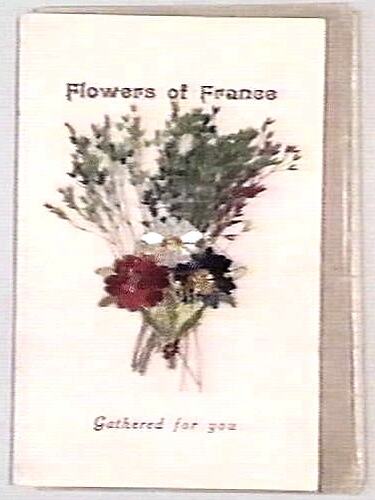Summary
Souvenir postcard from France 17.1.1917. Card headed 'Flowers of France gathered for you' with an embroidered spray of flowers. Written message on back headed "France 17.1.17. Dear Ethel...' - probably Miss Ethel Simms - and signed 'Edgar' Edgar James Mccarthy.
Edgar McCarthy was a 19-year-old labourer from Rosedale, Gippsland, Victoria, when he enlisted on 4 February 1916. As he was under 21 years of age, his father Henry gave his consent. Edgar was placed in the 8th Battalion, 17th Reinforcements (no. 5422) on 19 January and embarked for England on 4 April on the HMAT Euripides. He was shipped to France on 30 December 1916 and joined his unit on 4 February 1917 and his battalion on the 7th - probably in preparation for moving to the front. He was wounded in action on 16 April, including a fractured back and a severe head injury ('SW Head' may refer to a shell wound, although another document in his file refers to a gunshot wound). Edgar died at 8:40pm on 22 April at the 13th General Hospital, Boulogne, France. He had survived as little as ten weeks at the font.
Eight years later records in the National Archives indicate that his mother was 'still a patient at the Kew Hospital for the Insane'. Alice's incarceration was not related to the death of her son - she had been admitted there in 1899, probably as a result of post-natal depression. It is not known to whom thisand other items relating to Edgar was given, although a note in the Museum's supplementary file says that the donation of his material was 'handed to me (possibly the donor) from his mother, Alice McCarthy, about 1950'.
Description of Content
SOUVENIR POSTCARD FROM FRANCE 17.1.1917. CARD HEADED "FLOWERS OF FRANCE GATHERED FOR YOU EMBROIDERED SPRAY OF FLOWERS, RED, WHITE AND BLUE, WITH DYED GRASSES, GREEN, RED AND BLUE. WRITTEN MESSAGE ON BACK HEADED "FRANCE 17.1.17. DEAR ETHEL PROBABLY MISS E. SIMMS, AND SIGNED "EDGAR" EDGAR JAMES MCCARTHY.
Physical Description
Off-white postcard with printed inscription and embroidered spray of flowers, red, white and blue, with dyed grasses, green, red and blue. Written message on back.
Significance
Embroidered postcards from World War One are generally known as 'WW1 Silks'. They were first produced in 1914 and declined substantially from 1919; they are not found after around 1923. They were generally hand embroidered on strips of silk mesh with as many as 25 on a strip. They were mostly produced by French and Belgian women refugees who worked in their homes or refugee camps, and then sent the finished strips to factories for cutting and mounting on postcards. The postcards were very popular with British, Allied and American servicemen on duty in France. Many have patriotic themes and symbols, including the flags of Britain, France and America. It has been estimated that 10 million cards were produced.
www.ww1-propaganda-cards.com/silks.html, downloaded June 2006.
A second Web page suggests that the work was done by French women who were not necessarily refugees. 'The main themes were family remembrance; liberty, unity and right; sovenirs of France and of the war; regimental badges and crests'. www.english.emory.edu/LostPoets/Laffen.html, downloaded June 2006. Copies of these Web pages are in the Supplementary File for ST36590.
More Information
-
Collection Names
Military Memorabilia Collection, Returned and Services League (RSL) Collection
-
Collecting Areas
-
Acquisition Information
Donation & Subsequent Transfer from Victorian Branch, Returned & Services League of Australia Limited (RSL), Miss E. Simms, 02 Jun 1981
-
Author
Private Edgar J. McCarthy - 8th Battalion, A.I.F., France, 17 Jan 1917
8th Battalion, A.I.F. -
Organisation Named
-
Format
Postcard, Colour
-
Language
English
-
Inscriptions
Printed on front: 'Flowers of France/ gathered for you'. Hand-written inscription on reverse: 'France 17.1.17. Dear Ethel...'
-
Classification
-
Category
-
Discipline
-
Type of item
-
References
National Archives of Australia - Edgar James McCarthy, item barcode 1939171.
-
Keywords
Death & Mourning, Militaria: Australian, Military Memorabilia, Postcards, Wars & Conflicts, World War I, 1914-1918
